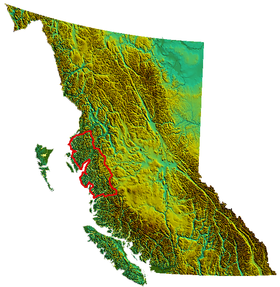The Kitimat Ranges are one of the three main subdivisions of the Coast Mountains in British Columbia, Canada, the others being the Pacific Ranges to the south and the Boundary Ranges to the north.
| Kitimat Ranges | |
|---|---|
| French: Chaînons Kitimat | |
 Lax Kw'alaams backdropped by Mount McNeil | |
| Highest point | |
| Peak | Howson Peak |
| Elevation | 2,759 m (9,052 ft)[1] |
| Coordinates | 53°50′N 128°30′W / 53.833°N 128.500°W |
| Dimensions | |
| Area | 62,777 km2 (24,238 sq mi) |
| Geography | |
| Location | British Columbia, Canada |
| Range coordinates | 53°49′59″N 128°30′05″W / 53.83306°N 128.50139°W[2] |
| Parent range | Coast Mountains |
Geography
editThe Kitimat Ranges lie between the Nass River and Portland Inlet in the north[2] and the Bella Coola River and Burke Channel on the south, and are bounded on their east by the Hazelton Mountains and include the mountainous islands of the North Coastal Archipelago, as well as King Island, which lies between Dean Channel and the aforesaid Burke Channel. Some of those islands are part of a separate formation known as the Coastal Trough.[3][4]
Although lower than the neighbouring Pacific Ranges to the south, they are in some ways more rugged, and are heavily indented by coastal inlets as well as by fjord-like lake valleys on the Interior side of the range.
Sub-ranges
editParks
editRivers
editRivers within or originating in, or which transit the Kitimat Ranges, are:
See also
editReferences
edit- ^ "Kitimat Ranges - Peakbagger.com". www.peakbagger.com. Retrieved 2021-11-26.
- ^ a b "Kitimat Ranges". BC Geographical Names. Retrieved 2021-02-24.
- ^ "S. Holland, Landforms of British Columbia, Province of British Columbia, 1976, p. 41" (PDF). Archived from the original (PDF) on 2016-03-04. Retrieved 2014-04-26.
- ^ "Map from Bulletin 48: Landforms of British Columbia" (PDF). Archived from the original (PDF) on 2016-03-03. Retrieved 2014-04-26.
